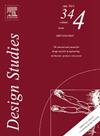An experiential learning approach to basic design studio
IF 3.2
1区 工程技术
Q2 ENGINEERING, MANUFACTURING
引用次数: 0
Abstract
This study explores an experiential learning approach in basic design education by integrating observations of the real world to improve students' learning motivation, self-efficacy, and performance. A quasi-experiment with 28 first-year industrial design students used a single-group pre- and post-test design over a nine-week studio. The short course included four learning units on natural observation for pattern analysis and shape reconstruction. Learning outcomes were assessed through scales, rubrics, T tests and regression analysis, while qualitative feedback was analyzed through text clouds. The results indicated an improvement in self-efficacy but mixed motivation for learning, probably due to the challenges in the reconstruction of shapes using generative rules and CAD tools. Students showed strong interest in field observation and generative rule exploration. The approach has positively influenced self-efficacy and learning performance. Future improvements include the alignment of tasks with the previous knowledge of students, the integration of user-friendly generative AI tools and the introduction of systematic problem-solving methods.
基础设计工作室的体验式学习方法
本研究旨在探索一种体验式学习方法,结合现实世界的观察,在基础设计教育中提高学生的学习动机、自我效能感和表现。对28名一年级工业设计专业的学生进行了一项准实验,在为期9周的工作室里采用了单组前测试和后测试设计。短期课程包括四个学习单元,以自然观察为模式分析和形状重建。通过量表、规则、T检验和回归分析对学习效果进行评估,并通过文本云对定性反馈进行分析。结果表明,自我效能感有所提高,但学习动机混杂,可能是由于在使用生成规则和CAD工具重建形状方面遇到了挑战。学生对实地观察和生成规则探索表现出浓厚的兴趣。该方法对自我效能感和学习绩效有正向影响。未来的改进包括将任务与学生以前的知识结合起来,集成用户友好的生成人工智能工具,以及引入系统的解决问题的方法。
本文章由计算机程序翻译,如有差异,请以英文原文为准。
求助全文
约1分钟内获得全文
求助全文
来源期刊

Design Studies
工程技术-工程:制造
CiteScore
8.60
自引率
20.00%
发文量
41
审稿时长
40 days
期刊介绍:
Design Studies is a leading international academic journal focused on developing understanding of design processes. It studies design activity across all domains of application, including engineering and product design, architectural and urban design, computer artefacts and systems design. It therefore provides an interdisciplinary forum for the analysis, development and discussion of fundamental aspects of design activity, from cognition and methodology to values and philosophy.
Design Studies publishes work that is concerned with the process of designing, and is relevant to a broad audience of researchers, teachers and practitioners. We welcome original, scientific and scholarly research papers reporting studies concerned with the process of designing in all its many fields, or furthering the development and application of new knowledge relating to design process. Papers should be written to be intelligible and pertinent to a wide range of readership across different design domains. To be relevant for this journal, a paper has to offer something that gives new insight into or knowledge about the design process, or assists new development of the processes of designing.
 求助内容:
求助内容: 应助结果提醒方式:
应助结果提醒方式:


